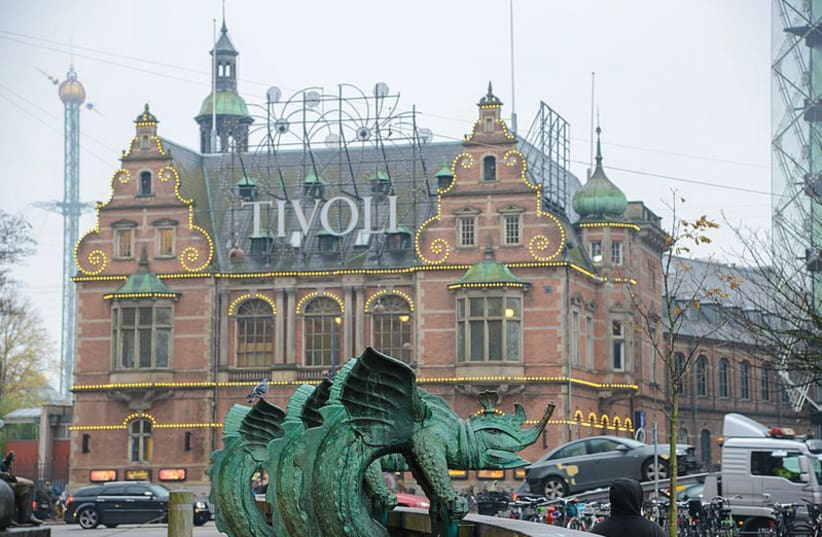For an overview, it’s a good idea to pick up a one-hour-canal tour from Nyhaven. Originally a busy cosmopolitan shipping port notorious for beer, sailors and “ladies of pleasure,” it was Hans Christian Andersen’s home from 1871 to 1875. It’s now Copenhagen’s number one attraction, with brightly colored merchants’ houses lining the canal and numerous inviting bars and ethnic restaurants.
The rain was torrential, but the boat’s glass roof protected us from the elements and afforded good views of the sights, including the royal palace complexes of Amalienborg and Christiansborg, the Opera House and, of course, the tiny bronze statue of the Little Mermaid, based on Andersen’s fairy tale and the symbol of Copenhagen. However, a word of advice: you only get a rear view of her from the boat and to see her in full glory you’ll need to take a train or cab.
Emerging from the boat into the downpour, we quickly made for Amagertorv, Copenhagen’s central square and main shopping drag. Here we chanced upon the delightful Café Norden, a real olde-worlde tea shop and, nursing our hot chocolates, we indulged in a serious bout of hygge, that peculiarly Scandinavian concept that means indulging in senses that impart a warm glow of cozy wellbeing.
Suitably fortified, the guidebook advised us on the enchanting dinner tables laid out at Royal Copenhagen Porcelain, whose flagship store was nearby. Each beautifully presented setting was designed by a different artist and inspired by Copenhagen’s sea connections. We were also charmed by the Flora Danica motifs, hand-painted after the 18th century botanical encyclopedia of that name.
Undoubtedly this is the best time of year to visit the Tivoli Gardens amusement park and we went one evening when the winter illuminations glitter and sparkle, reflected in the waters of Tivoli Lake, and stunning firework displays light up the skies. Opened in 1843, it inspired Walt Disney to create his own Disneyland. As well as the rides, there’s a concert hall, theater and aquarium, while for those with a sweet tooth, the Cakenhagen patisserie does exactly what it says on the tin.
Frederiksborg Castle is the ideal destination for a short trip out of town. Reached by a pleasant half-hour-train journey, this copper-turreted royal residence has its own lake and extensive gardens. Built by King Christian IV in the early 17th century to enhance his status, a fire destroyed much of it in 1859. Reconstruction – partly funded by the head of the Carlsberg Brewery – resulted in the 1882 opening of the Museum of National History and its ornate state rooms now catalogue Denmark’s history. A good tip is to buy the Copenhagen Card, with admission to 87 attractions together with free transport, including the canal trip and the train ride out to Frederiksborg.
THE FOLLOWING day was designated as our Copenhagen Castle Day. Everything was open and we also had to catch our flight home that evening. Making an early start in this very walkable city, we first visited Rosenborg. Set in Denmark’s oldest royal gardens, this was Christian IV’s favorite castle. When he was he was on his deathbed at Frederiksborg he insisted on being transported by sleigh to Rosenborg to die there.
There are a number of interesting rooms, including the Mirror Cabinet. Here, the King’s visitors could see themselves reflected in the ceiling, walls and flooring, problematic for women wearing the fishbone skirts fashionable at the time! You can also inspect the King’s original toilet. In the basement are the Crown Jewels which sparkle brilliantly in the half-light.
We relocated to the Christiansborg quarter, where the Copenhagen Jewish Museum is cocooned within Daniel Libeskind’s architectural vision. It explores Danish Judaism, exhibits numerous ritual objects and graphically tells the story of how, in 1943, the Danish Resistance Movement smuggled more than 7000 of Denmark’s Jews by sea to Sweden, thereby avoiding deportation to the Nazi death camps.
Incidentally, there is good kosher eating in Copenhagen at Taim, which offers succulent grilled chicken and steaks, together with a homemade amaretto liqueur known as Rochel’s Jewbrew. It’s situated in Chabad House, which ironically served as Nazi wartime headquarters.
Christiansborg was the last of our royal castle trio. Its ceremonial Throne Room is where the Queen receives heads of state and from its balcony a new monarch is always proclaimed, which last happened in 1972 when the present queen, Margrethe II, succeeded her father. The Great Hall, bedecked with flowers, silverware and porcelain, is the opulent setting for state banquets and New Year’s Eve celebrations. The Queen is driven to such parties in the 24-carat gold leaf carriage led by elegant white horses; both carriage and horses may be seen in a tour of the Royal Stables. The food for such occasions is actually now prepared at Amalienborg Palace (the Queen’s residence, where we watched the impressive Changing of the Guard at midday), but Christiansborg’s Royal Kitchen is authentically set up for a King’s dinner on 15 May 1937, complete with sizzling copper pots and the aroma of roasting chickens.
We left Copenhagen feeling that, like the English, the Danes have a distinguished and flourishing royal heritage which they are anxious to preserve and display. As a parting shot, we returned to Tivoli. Not to the Gardens, but to the adjoining Nimb Hotel, an exotic sugar-coated confection, all domes and minarets, whose lounge offers fine views of the Gardens in all their winter finery.
For the record, it doesn’t actually snow that much in Copenhagen. But even in the absence of the white stuff, Tivoli – like any good fantasy park– suspends disbelief and convinces you otherwise.
